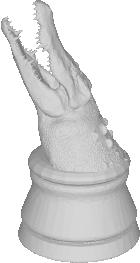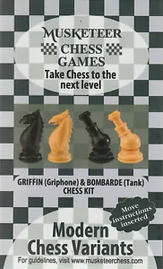Piececlopedia: Vao
Historical notes


The Vao is a diagonal version of the Pao, which is the Cannon from Chinese Chess. In A Guide to Fairy Chess (1969), A. S. M. Dickins reported that the Vao was introduced by T. R. Dawson from Chinese Chess, probably before 1914
(p. 11). Additionally, in an article called Remembering Thomas Dawson (28-xi-1889 16-xii-1951), John Upham said Dawson invented the Leo and Vao in 1912. However, it appears that P. Seyfert-Bitterfeld was the actual inventor, as Hans Bodlaender originally reported on an earlier version of this page. Reports that Dawson invented it are based on bad information. Dickins, who had previouly reported that Dawson had invented this piece, issued a correction on pages 327-8 of the May 1979 issue of The Problemist, writing
I am also grateful to Herr Albrecht for pointing out that the Pao, Vao, Mao family of pieces were in fact invented by Dr. P. Seyfert-Bitterfeld in an article in Die Schwalbe, Feb 1936, page 440, entitled PAO-MA. My statements in the Guide on page 11 about the Leo family should be amended accordingly, as also in the Short History page 8, and the Sunnucks Encyclopaedia of Chess, page 143. I have now been able to verify, in the Dawson manuscripts of all his fairy problems, that when he took the Grasshopper from the Chinese Canon in 1912 he did not also take the Pao/Mao/Vao pieces, and his first problem using a Mao was composed on 26th September 1945 and published in FCR in June 1946.
Unlike the Pao, which it is based on, the Vao is not from Chinese Chess. In fact, the name Vao is not Chinese. It appears to be a made-up word that was designed to sound something like Pao. Vao is not a Chinese word, and the letter V isn't even used in any system of Chinese transliteration. So the word has no meaning except as a name for this Chess piece.
Fergus Duniho has used the Vao in Yáng Qí (2001), Eurasian Chess (2003), and Gross Chess (2009). Trying to give it a more meaningful name, he first thought of Canon, which is a type of clergyman like the Bishop and a homonym for Cannon. Since this could be confusing when using both pieces in the same game, he picked the name Arrow instead. Since he was making Chinese character pieces for Yáng Qí, he picked the name based on the Chinese character he could use for it, which was 矢, transliterated as Shǐ. Besides referring to a projectile weapon, which is appropriate for a diagonal version of the cannon, another meaning of the character is vow, and because of that happy accident, he chose it over 弓, meaning bow, and 弩, meaning crossbow.
Charles Gilman continued the use of the name Arrow in Wildeurasian Qi and other games. Jean-Louis Cazaux has favored the name of Crocodile, which he borrowed from a historical name for the Bishop. According to comments made by Zhennen Su on this page, the Chinese have been calling it 弩, which means crossbow, since at least 2014. The reasons for this are that it combines better with other Chinese words than 弓 does, and like the cannon, the crossbow is a machine, which makes its meaning more similar to cannon. It's also probable that the Chinese were not as influenced by 矢 having the same meaning as an English word that is a homonym for Vao.
Movement
The Vao is a divergent piece, moving in one way and capturing in another. When it isn't capturing, it moves like a Bishop; when it does capture, it moves diagonally like a Bishop, except that it must jump over a single intervening piece, which may belong to any player. It moves like a Bishop until it reaches this piece, leaps over it, and continues moving like a Bishop until it captures its target. When it isn't capturing, it may not leap; and it may not capture without leaping.
Movement diagram
The Vao on d5 can take the black rook on a8 and the black knight on a2; it can also move to the squares marked with a black circle.
Checkmating
The Vao cannot inflict checkmate on a rectangular board with only assistance of its own King, (and neither can a pair of them), and is thus a minor piece. The problem here is that it needs an extra piece to use as a screen to activate its captures. And even when activated is is a color-bound piece, so the screen should attack a fair number of squares itself before a mate posiiton can even exist. The compound of Knight and Wazir (sometimes called Marquis) appears to do it. You can practice this here.
Images
Click on an image to view the full piece set it belongs to.
|
|
|
|||||||||||
Printable Pieces
The following designs are available for printing on a 3D printer. Links are to Thingiverse.




Commercial Pieces
While it is not strictly made for this piece, the Bombarde Musketeer Chess piece may be suitable for the Vao. It resembles a cannon, and unlike the cannon from Musketeer Chess, it slants at a diagonal angle instead of pointing straight up. This set comes with one of each color.

References
Dickins, Anthony. A Guide to Fairy Chess, 1969.
This is an item in the Piececlopedia: an overview of different (fairy) chess pieces.
Originally written by Hans Bodlaender. Various revisions made and piece images added by Fergus Duniho. Checkmating section by H. G. Muller.
WWW page created: December 23, 1999. Last updated: April 18, 2025.



